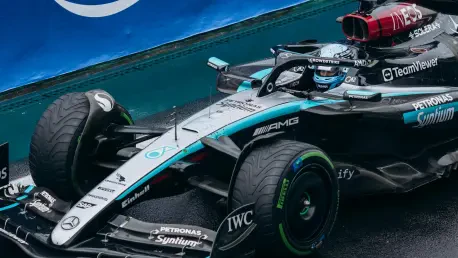Introduction
Imagine a Formula 1 race where every car speeding down the track is made entirely from recycled materials, leaving behind a negligible environmental footprint. This vision, while ambitious, is becoming a focal point in the high-octane world of motorsport, where sustainability is increasingly critical. The environmental impact of F1 car manufacturing, coupled with the sport’s global influence, makes this an urgent topic for teams like McLaren and Ferrari, which are under pressure to balance performance with eco-friendly practices.
The purpose of this FAQ is to explore whether a fully recycled F1 car is feasible, delving into the challenges, innovations, and implications of such an endeavor. Readers can expect to gain insights into the key barriers, material advancements, and strategic frameworks shaping this journey. By addressing common questions, this piece aims to clarify the complexities of integrating circularity—reusing, recycling, and reducing waste—into one of the most demanding sports on the planet.
This discussion will cover the environmental challenges of F1 manufacturing, the potential for sustainable materials, and the broader impact on the automotive industry. Each section is designed to provide clear, actionable information, helping to demystify how top teams might achieve a groundbreaking shift toward sustainability.
Key Questions or Key Topics
What Is the Environmental Impact of F1 Car Manufacturing?
The production of F1 cars generates a significant carbon footprint, primarily due to the intensive use of specialized materials and the rapid turnover of components. With each season, teams design and build multiple iterations of cars to stay competitive, resulting in a large volume of discarded parts. This relentless cycle of innovation, while essential for performance, poses a substantial challenge to environmental sustainability in the sport.
Beyond manufacturing, the logistics following races add to the ecological burden. Hundreds of components are inspected post-race, with items like tires and brake discs often replaced regardless of wear, contributing to waste accumulation. Addressing this impact is crucial, as it represents a major portion of a team’s overall environmental responsibility, pushing the need for systemic change in how resources are managed.
Can Current F1 Materials Be Replaced with Recycled Alternatives?
A primary obstacle to building a fully recycled F1 car lies in the materials used, many of which are non-recyclable due to the sport’s stringent safety and performance requirements. Specialized composites, for instance, are lightweight and durable but often lack viable sustainable substitutes that can withstand the extreme conditions of racing. This creates a fundamental conflict between maintaining a competitive edge and adopting greener practices.
Despite these hurdles, progress is being made with innovative material trials. McLaren, for example, has experimented with recycled carbon fiber in recent races and introduced bio-based flax fiber for car seats a few years ago. These efforts, while promising, highlight that sustainable alternatives must still meet rigorous standards, a balance that remains elusive for widespread adoption across all car components.
Expert input reinforces the complexity of this issue, with industry leaders noting that while incremental advancements are possible, a complete shift to recycled materials is not yet feasible. The focus, therefore, remains on gradual integration, prioritizing components where sustainable options can match or approximate the needed specifications without compromising safety or speed.
How Can F1 Supply Chains Adopt Circularity?
Transforming supply chains to embrace circularity—where materials are reused or recycled at the end of their lifecycle—is a daunting task for F1 teams. This process requires rethinking product design, business models, and even digital tracking systems to ensure efficiency and traceability. Such an overhaul is essential to minimize waste and reduce the environmental footprint of producing high-performance racing cars.
Experts in the field suggest that while challenging, these changes can yield benefits beyond sustainability, including improved operational resilience and cost efficiencies. A structured framework, such as the F1 Constructors’ Circularity Handbook developed with input from McLaren Racing and Deloitte, offers teams a way to measure the circularity of chassis materials. This tool helps identify gaps and set targets for improvement, providing a practical starting point for broader adoption.
The potential for success in this area is tied to collaboration across the industry, as teams must work with suppliers and partners to reimagine sourcing and disposal practices. By aligning on shared goals, there is an opportunity to create a ripple effect, influencing not just motorsport but also related sectors with similar supply chain dynamics.
Can F1 Innovations Influence the Wider Automotive Industry?
Formula 1 has long been a pioneer in automotive technology, with past innovations like advanced helmets and seatbelt designs eventually becoming standard in consumer vehicles. This historical precedent suggests that sustainability breakthroughs in F1 could similarly reshape broader manufacturing practices, particularly in how materials are sourced and reused. The sport’s high-profile platform amplifies its ability to drive such change on a global scale.
Industry leaders believe that pushing for circular practices within F1 can normalize sustainability across supply chains, making eco-friendly solutions more accessible and affordable. If teams like Ferrari and McLaren succeed in integrating recycled materials or circular processes, the resulting technologies and methodologies could trickle down to everyday automotive production, benefiting both the environment and end consumers.
This potential impact underscores the importance of F1’s current efforts, as the sport’s fast-paced environment serves as a testing ground for cutting-edge ideas. By leveraging its influence, F1 has the chance to lead by example, encouraging other industries to adopt similar principles of resource conservation and waste reduction in their operations.
Summary or Recap
This FAQ highlights the multifaceted challenges and opportunities surrounding the creation of a fully recycled F1 car by teams like McLaren and Ferrari. Key points include the significant environmental impact of F1 manufacturing, the limitations of current materials in meeting sustainability goals, and the critical role of supply chain transformation in achieving circularity. Additionally, the potential for F1 innovations to influence the wider automotive sector stands out as a compelling driver for continued progress.
The main takeaway is that while a completely recycled F1 car is not currently achievable due to material and performance constraints, incremental steps through innovation and collaboration are paving the way. Tools like the F1 Constructors’ Circularity Handbook provide a measurable foundation for teams to enhance their environmental practices, focusing on gradual improvements across various components.
For those seeking deeper exploration, resources on sustainable motorsport initiatives or studies on circular economy principles in high-performance industries can offer further insight. Engaging with industry reports or following updates from the FIA and team sustainability directors can also provide a closer look at ongoing developments in this evolving field.
Conclusion or Final Thoughts
Reflecting on the discussions held, it becomes evident that the path to a fully recycled F1 car demands persistent effort and ingenuity from teams like McLaren and Ferrari. The hurdles of material limitations and supply chain complexities are acknowledged as significant, yet the strides made in testing sustainable alternatives inspire hope for future breakthroughs. The recognition of F1’s potential to influence wider industries adds a layer of urgency to these endeavors.
Looking ahead, a practical next step would be for stakeholders to prioritize investment in research for recyclable materials that meet F1’s exacting standards. Collaborative platforms could be established to share data and best practices, accelerating the adoption of circularity across teams and suppliers. Such actions would not only advance sustainability in motorsport but also set a precedent for other high-impact sectors to follow.
This topic invites consideration of how individual choices in supporting sustainable practices could amplify industry efforts. Exploring ways to advocate for or engage with eco-conscious initiatives in motorsport could contribute to a collective push toward a greener future, aligning personal values with global environmental goals.









